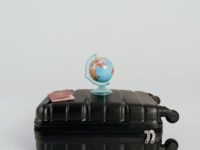Guest post by Maria Harutyunyan
Packing an extra large suitcase requires careful planning and strategic organisation, especially when you’re preparing for extended trips or need to carry a wide range of items. To successfully pack your belongings, the first step is securing the right luggage that will withstand the weight and bulk of your contents. XXL luggage by Eminent has the capacity and durability necessary for such occasions while keeping valuables safe. Additionally, reputable brands like Travelpro offer reliable and spacious alternatives tailored to meet these packing requirements while prioritising functionality and convenience.
Once you have chosen your extra large suitcase, the packing process becomes a meticulous task of fitting in everything you need. It is essential to prioritise items based on necessity and frequency of use, making sure that the most important things are both protected and accessible. By understanding the best ways to utilise the space within your suitcase, you can ensure that your belongings are not only packed efficiently but also organised in a way that makes unpacking a breeze upon arrival.
Key Takeaways
- Choose sturdy and spacious XXL luggage for extensive packing needs.
- Prioritise items based on the necessity to streamline the packing process.
- Arrange belongings for both efficient use of space and ease of access.
Selecting Your Suitcase
When preparing for a trip, the right suitcase can make all the difference. Your luggage should be spacious while adhering to airline regulations, and it must be durable to withstand the rigors of travel.
Hard vs. Soft Shell Suitcases
Hard Shell Suitcases are known for their durability and protection. They’re ideal if you’re carrying fragile items or traveling through harsh weather conditions. On the other hand, Softside Suitcases offer more flexibility and may have external pockets for easy access to your belongings. They can also be compressed slightly to fit into tight spaces, making them a practical choice for checked luggage.
Considering Suitcase Size and Weight
When choosing a suitcase, size is paramount. For longer trips, an Extra Large Suitcase affords you ample space without compromising on ease of movement. Keep in mind the weight of the suitcase, especially when it’s empty. Airlines have strict weight limits for both carry-on and checked luggage, and an overly heavy case could incur additional charges.
Features to Look for in a Suitcase
Your suitcase should have several important features:
- Handles: Look for a telescopic handle that’s sturdy and ergonomic. Side handles are also crucial for lifting.
- Wheels: A suitcase with smooth, multi-directional wheels can provide better maneuverability.
- Compartments: Internal compartments aid in keeping your belongings organised.
- Locks: Integrated locks enhance security.
- Material: The material of your suitcase impacts both weight and durability. Hard shells often use polycarbonate, while soft cases may use high-denier fabric.
Select a suitcase that balances these features with price – investing in high-quality luggage can save you from future headaches on your travels.
Packing Your Suitcase
Mastering the art of packing an extra-large suitcase requires an understanding of space maximisation and organising techniques. The key is to ensure every item has its place, accessibility is maintained, and your belongings are protected.
Clothing Strategy and Techniques
Begin by selecting versatile outfits that can be mixed and matched. Hold on to two principles: rolling your clothes to prevent wrinkles and save space and deploying the layering method. Focus on wrinkle-resistant fabrics for a polished look upon arrival. Lay out your tops, bottoms, underwear, socks, and dress options, then proceed with the following steps:
- Rolling Clothes: Tightly roll softer garments and place them at the bottom of the suitcase.
- Folding: For stiffer fabrics prone to creasing, fold neatly.
- Bulky Items: Pack items like a suit jacket or exercise gear along the edges or wear them during travel to save space.
Utilizing Packing Accessories
Packing cubes and compression bags are your allies in the organisation. They categorise your items and compress clothing to maximise available space. Use them strategically:
- Packing Cubes: Sort clothes by type or outfit — one for tops, another for bottoms, etc.
- Compression Bags: Reserve for bulky items like sweaters or jackets.
- Specialised Accessories: Consider a jewellery roll to prevent tangles and a cube for electronic devices including your phone charger and camera.
Packing Non-Clothing Items
To maintain order and prevent spillage, separate toiletries and hair products, limiting them to travel sizes to minimise toiletries. Equip yourself with a TSA-approved clear bag for liquids.
- Shoes: Encase shoes in bags to isolate them from clothing. Place them around the perimeter of your suitcase, sole side out.
- Souvenirs: If planning for souvenirs, allocate space in advance to avoid overstuffing on the return journey.
Final Checks and Preparing for Departure
Crafting a packing list is instrumental in the process. Confirm that all essentials, such as prescriptions, swimsuits, hats, and chargers are included. Perform a final check:
- List Crosscheck: Confirm that each item on your packing list is accounted for.
- Cushion Delicates: Provide extra padding for fragile items.
- Accessibility: Place items you’ll need first or frequently on top or in outer pockets.
- Departure Readiness: Weigh your suitcase to avoid any airline fees and ensure easy transit.
By adhering to these structured packing methods, you’ll travel confidently knowing that everything you need is compactly and safely stored in your extra-large suitcase.
Conclusion
Packing an extra large suitcase efficiently is all about utilising space and prioritising essential items. By carefully selecting what to bring and employing the use of packing cubes and other organisers, you ensure that your belongings are both secure and easily accessible. Wearing your bulkiest items can save you significant space, and the strategic placement of items like shoes and toiletries can prevent shifting and crushing. Remember that the most successful packing strategy is one that considers all phases of your travel, maintaining organisation and accessibility throughout your journey.





